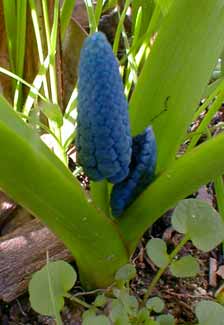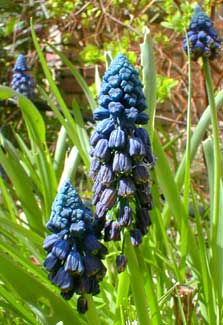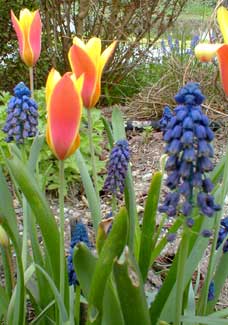
Bellevalia Grape Hyacinths
"Arise! young Queen of forests green,
A path was strewn for thee
With hyacinth, & gold bells atween,
And red anemone;
Arise! young Queen of beauty & delight,
Lift up in this fair land thine happy eyes;
The valleys yearn, and gardens for thy sight,
But chief this heart that prays for thee with sighs."
-Frederick Tennyson,
1807-1898
1807-1898
This relative of & near look-alike for Muscari grape hyacinths was formerly called both Muscari pycnantha & M. paradoxum, but today is placed in a different genus as Bellevalia pycantha. It is native to Eastern Turkey, Northern Iraq, Northwest Iran, & Armenia.
We planted a dozen bulbs in Autumn 2003 in front of a native wild Rosy Spirea together with Society Garlic & other bulbs.
At the same time we planted a second drift of twenty Bellevalia Grape Hyacinth bulbs on the street margin right next to the sidewalk, mixed with the Candlestick Tulip Tulipa clusiana var chrysantha. The third photo below shows them with the Candlestick Tulips in April.
 It is very hardy, though not adaptable to quite the same high degree as are such grape hyacinths as Muscari botryoides, which will take sun or part shade, in either dry or moist conditions. The Bellevalia Grape Hyacinth requires a somewhat better-watered location exclusively in full sun, though a little dryness now & then won't be harmful, & sharp drainage is a plus.
It is very hardy, though not adaptable to quite the same high degree as are such grape hyacinths as Muscari botryoides, which will take sun or part shade, in either dry or moist conditions. The Bellevalia Grape Hyacinth requires a somewhat better-watered location exclusively in full sun, though a little dryness now & then won't be harmful, & sharp drainage is a plus.Though it might be successfully grown in zones 4 through 10, this wildflower is not as winter-hardy as true muscaris, & their ideal hardiness range is in zones 7 & 8, where they will naturalize very happily.
It in general looks & behaves a great deal like it's cousin, growing taller however, the flowers' stems growing to around a foot or sixteen inches high. It has cone-shaped navy blue flowers which appear as bright blue buds at mid-March, as shown in the photo above, & in full bloom later in March & in April, as shown in the second photo. Even just as buds & immature flowers, they are quite impressive.
 Some will consider B. pycantha redundant if ther are already Muscari species of grape hyacinths in the garden. Others who love grape hyacinths for their beauty & reliability will feel B. pycantha has just enough distinctiveness to justify its addition, Its blueness is a flatter mat-navy compared to the purer blue of Muscari armeniacum or M. botryoides.
Some will consider B. pycantha redundant if ther are already Muscari species of grape hyacinths in the garden. Others who love grape hyacinths for their beauty & reliability will feel B. pycantha has just enough distinctiveness to justify its addition, Its blueness is a flatter mat-navy compared to the purer blue of Muscari armeniacum or M. botryoides.In the colder zones of their potential tolerance, they wait until late spring to bloom. Its ribbony grass is thicker than the typical muscari, deep green & most attractive, although it's a bit unfortunate how snails like these leaves more than average.
It was first described in 1835, but is not one of the most common offerings, perhaps because they duplicate muscari too closely. Yet the richness of the blue & greater openness of the bells (which are pinched shut on muscaris, like drawstring purses, yet even so a bit bell-like) does make this a stand-out for its own merits.
At its best it can actually outshine its cousins. There are several other Bellevalia species that are only rarely offered for the garden, & don't have the same visual impact, thus are often dismissed as ornamentally insignificant.
The one other Bellevalia species we do have, B. romana, more resembles scilla than grape hyacinths, & subdued even in comparison to scilla.